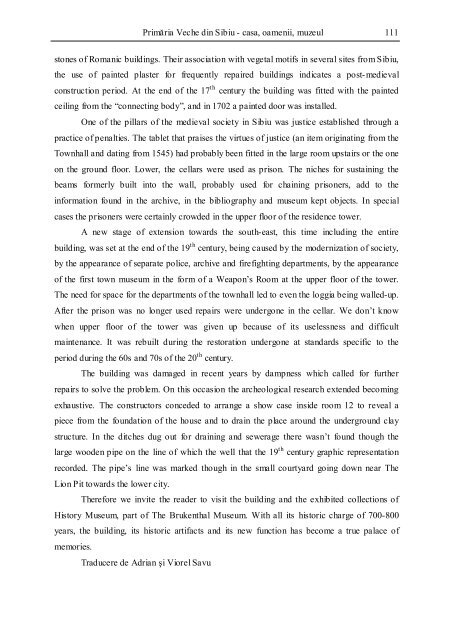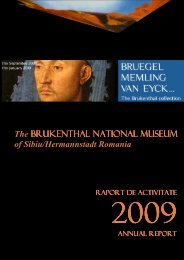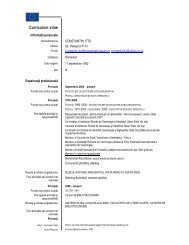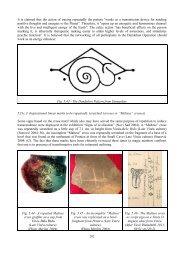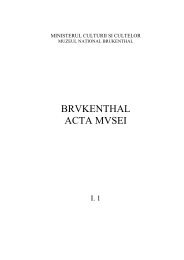PRIMĂRIA VECHE DIN SIBIU casa, oamenii, muzeul
PRIMĂRIA VECHE DIN SIBIU casa, oamenii, muzeul
PRIMĂRIA VECHE DIN SIBIU casa, oamenii, muzeul
Create successful ePaper yourself
Turn your PDF publications into a flip-book with our unique Google optimized e-Paper software.
Primăria Veche din Sibiu - <strong>casa</strong>, <strong>oamenii</strong>, <strong>muzeul</strong> 111<br />
stones of Romanic buildings. Their association with vegetal motifs in several sites from Sibiu,<br />
the use of painted plaster for frequently repaired buildings indicates a post-medieval<br />
construction period. At the end of the 17 th century the building was fitted with the painted<br />
ceiling from the “connecting body”, and in 1702 a painted door was installed.<br />
One of the pillars of the medieval society in Sibiu was justice established through a<br />
practice of penalties. The tablet that praises the virtues of justice (an item originating from the<br />
Townhall and dating from 1545) had probably been fitted in the large room upstairs or the one<br />
on the ground floor. Lower, the cellars were used as prison. The niches for sustaining the<br />
beams formerly built into the wall, probably used for chaining prisoners, add to the<br />
information found in the archive, in the bibliography and museum kept objects. In special<br />
cases the prisoners were certainly crowded in the upper floor of the residence tower.<br />
A new stage of extension towards the south-east, this time including the entire<br />
building, was set at the end of the 19 th century, being caused by the modernization of society,<br />
by the appearance of separate police, archive and firefighting departments, by the appearance<br />
of the first town museum in the form of a Weapon’s Room at the upper floor of the tower.<br />
The need for space for the departments of the townhall led to even the loggia being walled-up.<br />
After the prison was no longer used repairs were undergone in the cellar. We don’t know<br />
when upper floor of the tower was given up because of its uselessness and difficult<br />
maintenance. It was rebuilt during the restoration undergone at standards specific to the<br />
period during the 60s and 70s of the 20 th century.<br />
The building was damaged in recent years by dampness which called for further<br />
repairs to solve the problem. On this occasion the archeological research extended becoming<br />
exhaustive. The constructors conceded to arrange a show case inside room 12 to reveal a<br />
piece from the foundation of the house and to drain the place around the underground clay<br />
structure. In the ditches dug out for draining and sewerage there wasn’t found though the<br />
large wooden pipe on the line of which the well that the 19 th century graphic representation<br />
recorded. The pipe’s line was marked though in the small courtyard going down near The<br />
Lion Pit towards the lower city.<br />
Therefore we invite the reader to visit the building and the exhibited collections of<br />
History Museum, part of The Brukenthal Museum. With all its historic charge of 700-800<br />
years, the building, its historic artifacts and its new function has become a true palace of<br />
memories.<br />
Traducere de Adrian şi Viorel Savu


